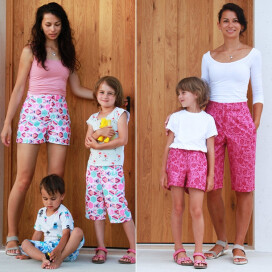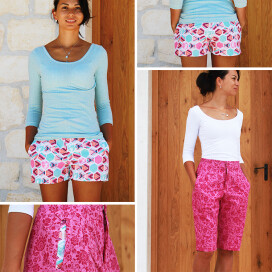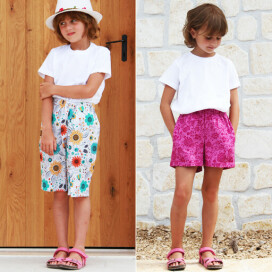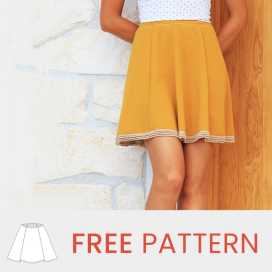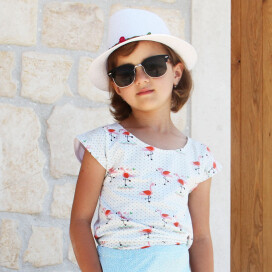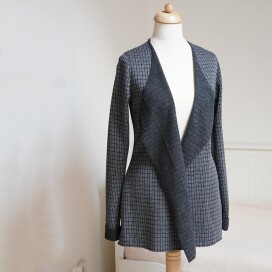Pattern - Children’s softshell pants LET’S GROW (growing pants)
- The pattern for children’s softshell pants is constructed in a professional program for clothing pattern development and it is available in sizes 80 – 164 (find size chart below).
- The pattern is in PDF format (A4 and A0 pages) and it will be sent electronically to your email after purchase.
The basic idea of “growing” clothes
The basic idea of growing clothing is that a child can wear it even if it grows by one size (in the case of slimmer children even by two sizes). The pants are wide and long enough to “grow” with children over two seasons. The wide hems on the legs can be tucked inside at the beginning so that the legs are hanging over them. As the kid grows, the hems are shifting to the classic position and the pants are “extending” up to their final length. Hem knit in the waistline works similarly. There is a small hole that allows you to replace the inner elastic waistband as the kid grows. You can use a stronger one at the beginning, replace it with a looser one later and eventually pull it out completely, so that the pants are held in place only by the hem knit itself. If you sew the pants now, the kids will be able to wear them during the spring and probably during the next autumn too. If you have an older (bigger) kid, pants will probably serve you even longer, because larger children no longer grow as fast as the smaller ones. This is how they grew with Tomík - Summer 2017 vs. Autumn 2019 (still the same pants): Pattern - children’s softshell pants - “growing” pants
Pattern - children’s softshell pants - “growing” pants
Children’s pants LET’S GROW – Overview
Knee patches are segmented, allowing children to play comfortably while sitting or kneeling. This also prevents the knee area from becoming stretched out. You can sew the knee patches from top fabric or contrasting material, as the patches are a separate part of the pattern. Knee patches can be done in two different versions (both of the same practicality and allowing for the same freedom of movement). There is the version with one counter-fold (black pants in my photos) or the version with darts (two on both sides of the knee, blue and orange pants in my photos). Hem knits for legs & waist These pants have legs and waist with hem knits. Stretchy hem knits are a great choice here because they provide a lot of growing space. When the children are smaller, you can simply hide them inside the pants, which will prevent them from getting wet in rainy weather. They also provide an additional insulating layer. As the children grow, the hems can gradually extend from the pants. This allows the children to wear pants longer without the need to buy bigger ones… The yoke of the back piece shapes the rear part of the pants. But you can also use it to give pants a more interesting look (using contrasting fabrics etc.). There is a smaller patch pocket in the back piece. Front pieces have large side pockets, which can hold a lot of treasures.Difficulty level:
This pattern is suitable for daring beginners and intermediate sewers.Recommended material
I recommend using medium and thick woven fabrics (inelastic materials) for these pants. Winter softshell (fleece on the reverse side) or spring softshell (knits on the reverse side) is ideal. But you can use all kinds of fabrics suitable for sewing pants. If you choose thin summer softshell, please be aware that the pants may be a bit loose.How to sew the children’s softshell pants step-by-step
Detailed photo instructions on how to sew children's softshell pants can be found here:How to sew children's softshell pants
What a pattern from Picolly.com looks like
There are three versions of this pattern (you will receive all of them after purchase):- 1st version (one size view) – PDF A4 – pattern in individual sizes with seam allowances outlined– all individual sizes of the pattern (pattern of each size shows sewing lines and seam allowances are outlined too).
- 2nd version (classic view) – PDF A4 pattern showing all sizes without seam allowances - all sizes are outlined “in one picture”(each in its own color) without seam allowances.
- You can choose what works best for you. The advantage of the classic view (where all the sizes are shown) is that you can easily customize your pattern to fit body types in between the chart sizes. One size view saves time during preparation - you do not have to think where and how much to add for the seams, because everything is already there.
- 3rd version (classic view) – PDF A0 pattern showing all sizes without seam allowances. This large-format pattern does not need to be glued together. You can print it on a home or office plotter or in one of the many copy centers.
 What a pattern from Picolly.com looks like
The pattern is in PDF format and it will be sent to your e-mail after the payment. Check out my article on how to assemble the paper pattern from A4 pages.
What a pattern from Picolly.com looks like
The pattern is in PDF format and it will be sent to your e-mail after the payment. Check out my article on how to assemble the paper pattern from A4 pages.
When and how do I receive my pattern?
After the payment has been credited to the account, I will immediately send the pattern with sewing instructions in PDF format to your e-mail address. Patterns and tutorials are sent from the system automatically (immediately after the payment). The order processing process is fully automated, so you must enter the correct email address (without typos). You also need to send your payment with the correct variable symbol (variable symbol = number of your order). After receiving the pattern, it is necessary to print it and assemble the sheets (glue them together). If you are concerned that this will be difficult or lengthy, check out this simple guide on how to assemble the paper pattern easily.
Size chart (children’s sizes CLASSIC)(the measurements are in centimeters) |
|||||||||||||||
| Size | 80 | 86 | 92 | 98 | 104 | 110 | 116 | 122 | 128 | 134 | 140 | 146 | 152 | 158 | 164 |
| Body height | 80 | 86 | 92 | 98 | 104 | 110 | 116 | 122 | 128 | 134 | 140 | 146 | 152 | 158 | 164 |
| Chest | 50 | 52 | 54 | 55 | 56 | 57 | 58 | 60 | 61 | 63 | 64 | 67 | 71 | 74 | 78 |
| Waist | 50 | 52 | 54 | 55 | 56 | 57 | 58 | 59 | 60 | 61 | 62 | 63 | 65 | 67 | 69 |
| Hips | 55 | 56 | 58 | 59 | 61 | 63 | 65 | 67 | 69 | 71 | 74 | 78 | 82 | 86 | 90 |
Declaration
Pattern, including instructions and all photographs, is a copyrighted work, and any distribution, copying, or disclosure to third parties is prohibited and will be considered a violation of the Copyright Act (Copyright Act, Act No. 121/2000 Coll. / Zákon o právu autorském – Zákon č. 121/2000 Sb., Česká Republika), which may be prosecuted. Contents of the pattern (and instructions) are based on the personal experiences of the author. Your successes and possible failures are in your hands and the author bears no responsibility for them. But that doesn’t mean you’re on your own. Whenever you need advice, please do not hesitate to contact me at petra@picolly.comNotice to companies
The pattern is not intended for commercial use. If you are a tailor (for example) and you want to use any of my patterns for commercial purposes, please do not hesitate to contact me. I will be happy to discuss my options with you and create a bespoke offer for you.For best results, please read the following:
- The patterns are constructed in ready-made sizes because it is not possible to construct a pattern for all body types (the size chart would get too congested).
- To make the clothes fit the individual figure perfectly, you need to carefully measure it first. Then compare measurements with the size chart and paper pattern. That is the only way to find the right pattern size.
- Besides, it’s almost always necessary to adjust the pattern slightly to make it fit perfectly. (Even if we have two women whose measurements are the same, they will differ in other ways – one of them may have a narrower back and a larger bust, the other may be more muscular with a smaller bust. One of them may also have wider hips and flatter buttocks, the other may have narrower hips and rounder buttocks…) Patterns (and their sizes) are only rough guidelines. If you are going for a perfect fit, you need to perform fitting tests and adjust the garments accordingly. Sewing is a creative activity and you need to take into account that each of us is built differently. THIS APPLIES TO CHILDREN’S AND MEN’S CLOTHES TOO – WE ARE ALL UNIQUE.
- If you are using some pattern for the first time, always sew a “test sample” from a cheaper fabric first. Mark any adjustments in the paper pattern and then use it to sew the final product. It is a classic tailoring method. No two fabrics are the same, therefore, please note that what works with one fabric may not work with another. That is why you should always sew test samples. Sewing is not like baking, you can’t just pick the pattern and expect the perfect results without some measuring, testing, and adjusting. That’s just how it works.
- I also recommend temporarily stitching all seams that affect circumferences (such as side seams, instep seams, etc.) before sewing. So, you can try the garment on and adjust it if necessary. Do not underestimate ironing and testing the clothes during the sewing process.
- Also, don’t forget to carefully mark seam allowances. Beginners often forget about them. It is necessary to measure seam allowances with the measuring tape around the entire pattern and then sew along the correct sewing lines – seam allowances width away from the cutting edges. Careless work with the seam allowances can result in large deviations in the overall widths and lengths of the individual pieces.
- When positioning the paper pattern pieces always make sure that the pieces are oriented correctly.
Free patterns:
Not sure whether to buy a pattern? Not sure what the pattern will look like and if you ever be able to put it together? Download one of my patterns for free and see what it looks like and try using it. Free patterns are in the same format as the patterns available in the store. You check them out here:Worth reading:
- How to assemble the paper pattern
- How to transfer the paper pattern to the fabric
- How to adjust the pattern
- How to scale the pattern proportionally
- How to baste the fabric
- How to choose a sewing machine needle
- Sewing elastic fabrics with a regular sewing machine – 4 steps to success
- 5 sewing tools that you cannot buy in the haberdashery
- How to choose a sewing machine – 5 important tips


















































